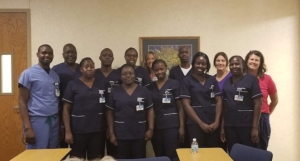
Billy Tanui, CRNA, is passionate about anesthesia education, both here in the U.S. and in his home country of Kenya. His long-term goal is to introduce epidurals to the country for women during childbirth, with a focus on rural areas like the one in which he was raised.
“Things like epidurals are basically nonexistent in Kenya,” said Tanui, a Certified Registered Nurse Anesthetist (CRNA) who lives and works in Kansas City, Missouri. “After seeing what epidurals do, and how satisfied and happy patients are in their labor when they receive epidurals, I want to do more to help women in Kenya.”
Three years ago, he was part of a collaborative project to bring nine nurses from Nandi County in Kenya to the United States for a three-month international immersion program. The nurses shadowed other nurses at Truman Medical Center and learned about the American healthcare system.
While the Kenyan nurses didn’t come to the U.S. to specifically learn about epidurals, they shadowed in different areas of the hospital, including obstetrics, to bring information and best practices back to Kenya. Tanui said he has a good relationship with some of the nurses who visited and would love to bring education about neuraxial anesthesia — which includes epidurals and spinal blocks — to their hospital.
Only 2% of women in Kenya receive epidurals during labor, and almost no epidurals are given in rural areas. “The attitude is that women are in pain when they deliver babies, and that’s how life is,” Tanui said.

The country of 40 million people also faces a shortage of anesthesia providers, with only 202 physician anesthesiologists and 108 nurse anesthetists, according to the World Federation of Societies of Anesthesiologists. Before becoming a CRNA, Tanui did three medical missions to Kenya. He provided basic healthcare education and wound care on those trips. He had planned a medical mission event for 2021 specifically to provide anesthesia services to residents but had to cancel due to issues related to the COVID-19 pandemic, in addition to unethical behavior from medical board officials in Kenya who expected payment from the volunteers.
Further efforts include organizing a group of CRNAs and physician anesthesiologists to travel to Kenya in the future to help provide quality anesthesia care for surgeries and neuraxial anesthesia for parturients. He also hopes to one day set up a facility for women that will provide neuraxial anesthesia — an area of anesthesia he describes as a passion. He finds working in obstetrics to be one of the most rewarding parts of being a CRNA.
“I walk into a patient’s room, and they’re in agonizing labor pain. I give them an epidural, and within 10 to 15 minutes it’s like night and day. It’s almost magical — one minute they’re in pain, and the next minute, they’re comfortable,” Tanui said.
He remembers a card a patient wrote to him when she had a C-section, thanking him for the exemplary care he provided. At the time, he was a student registered nurse anesthetist.
“She called me the ‘anesthesia man’ and thanked me for making her comfortable and alleviating her pain, anxiety, and fear. It was really touching to me. It felt like not only did I do my job, but I did what I was called to do when I went to anesthesia school, which is to help others. Patients may feel scared, or they may not understand everything that is happening, especially in urgent or emergent situations. In this case, I was able to provide information, provide my expertise, and provide the comfort she needed at the time,” he said.
Currently, he teaches a class about neuraxial anesthesia at University Health Truman Medical Center School of Nurse Anesthesia and trains nurse anesthesia students in the operating room. His strong interest in neuraxial anesthesia stems from a project on epidurals he did as a nurse anesthesiology student. Having just graduated in 2019, he said he has a keen understanding as an educator of how nervous students may be when they’re beginning their anesthesia training.
“My job is to be able to help students overcome some of the fears they have and teach them in the best way that I know how,” he said, adding that he enjoys following up with students on their progress, even after graduation. “I had the privilege of learning the art of anesthesia from great and amazing CRNAs and anesthesiologists whom I also get the chance to work with every day. My happiness and joy is to be able to share what I’ve learned and pass that valuable information to the next generation of nurse anesthetists.”